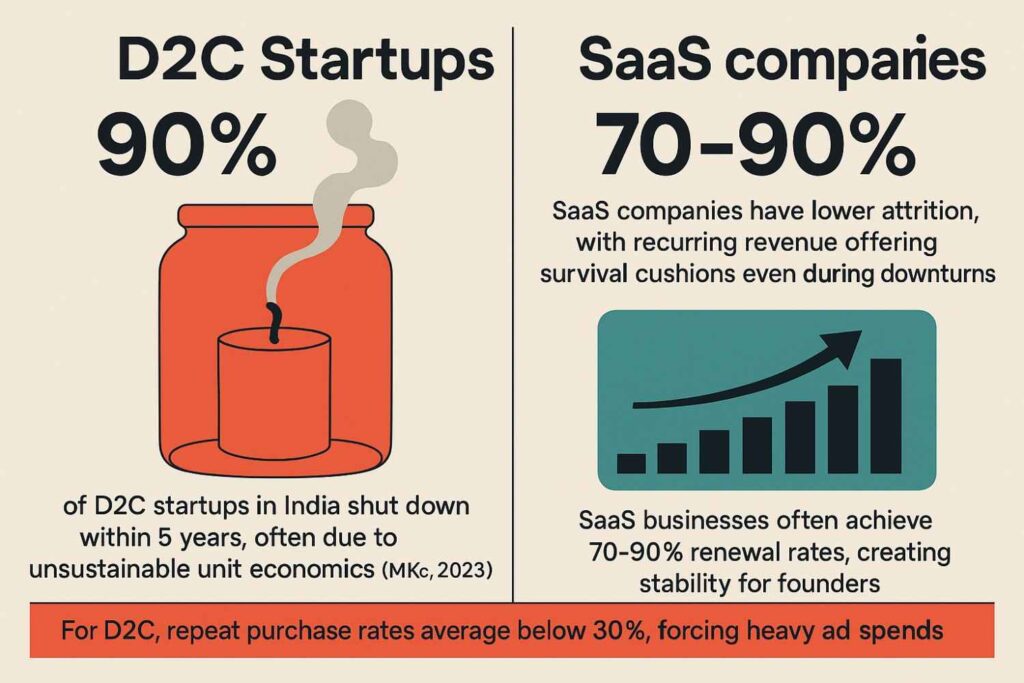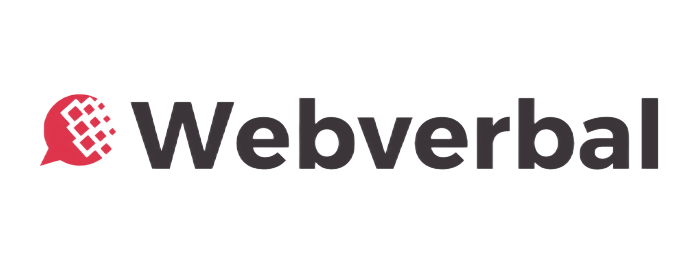Table Of Content
- Two Startup Journeys, Two Very Different Outcomes
- The Data Behind the Burnout
- Why D2C Founders Burn Faster
- 1. Thin Margins and Cash Burn
- 2. Consumer Price Sensitivity
- 3. Marketing Treadmill
- 4. Operational Firefighting
- Why SaaS Founders Feel “Safer”
- 1. Recurring Revenue Models
- 2. Stickier Customer Relationships
- 3. Scalable Sales Systems
- 4. Investor Perception
- The Founder Psychology Angle
- Case Studies: The Contrast in Action
- What Needs to Change
- For D2C Founders
- For Investors
- For the Ecosystem
- Key Takeaways
- Founder’s Closing Lens
Two Startup Journeys, Two Very Different Outcomes
In India’s startup ecosystem, Direct-to-Consumer (D2C) brands and Software-as-a-Service (SaaS) companies are often celebrated side by side. Both are seen as innovative, tech-enabled, and “scalable.” Both attract venture capital. Both aspire to be unicorns.
Yet talk to founders on the ground and you’ll hear two very different stories. SaaS founders, while dealing with long sales cycles, often enjoy predictable revenue and compounding growth once customers are onboarded. D2C founders, on the other hand, describe sleepless nights, endless firefighting, and a constant treadmill of customer acquisition.
The difference isn’t about hustle. It’s about the fundamental business models. And that’s why D2C founders burn out faster than SaaS founders.
The Data Behind the Burnout

The gap is stark when you look at failure rates and growth trajectories:
- 90% of D2C startups in India shut down within five years, often due to unsustainable unit economics (McKinsey, 2023).
- SaaS companies have lower attrition, with recurring revenue offering survival cushions even during downturns.
- For D2C, repeat purchase rates average below 30%, forcing heavy ad spends.
- SaaS businesses often achieve 70–90% renewal rates, creating stability for founders.
This isn’t about founder capability. “90% of D2C startups in India shut down within five years, often due to unsustainable unit economics (McKinsey, 2023).This aligns with broader founder challenges I explored in Why Most Indian Startups Fail: A Case Study-Led Dive into Behavioral Blind Spots, where behavioral blind spots accelerate these failures.”
It’s structural. Burnout is built into the D2C model, while SaaS offers a more forgiving path once product-market fit is achieved.
Why D2C Founders Burn Faster
1. Thin Margins and Cash Burn
D2C founders battle a brutal math problem. Discounts, return-to-origin costs, last-mile logistics, and influencer campaigns eat into margins. Even when sales rise, profit often does not. Founders end up in a cycle of raising funds just to survive.
2. Consumer Price Sensitivity
Indian consumers are price hawks. A ₹50 difference can shift loyalty overnight. D2C founders fight not only competitors but also platforms like Flipkart and Amazon, which condition buyers to expect discounts. This constant race to the bottom exhausts both margins and morale.
3. Marketing Treadmill
Every D2C sale feels like starting over. Paid ads, influencer marketing, and flash sales drive spikes but not sustained loyalty. When customer acquisition costs (CAC) rise — as they inevitably do — founders find themselves burning energy just to stand still.
4. Operational Firefighting
From inventory stockouts to COD fraud, D2C founders live on the frontlines. Every angry customer email feels personal. The emotional tax of daily firefighting accelerates burnout.
Why SaaS Founders Feel “Safer”
1. Recurring Revenue Models
SaaS thrives on subscriptions. Once a customer signs on, revenue compounds. This predictability reduces stress, giving founders breathing room.
2. Stickier Customer Relationships
B2B clients are slower to acquire, but once onboard, they’re harder to dislodge. Contracts, integrations, and switching costs make churn lower than in consumer businesses.
3. Scalable Sales Systems
SaaS founders can build repeatable playbooks — outbound sales, inbound funnels, partner ecosystems. Once cracked, the system scales without exhausting founders daily.
4. Investor Perception
Investors view SaaS as “capital efficient” and “global scalable.” D2C, by contrast, is seen as “cash guzzling.” This affects not just valuations but also the pressure put on founders.
The Founder Psychology Angle
Behind the numbers is psychology.
- D2C founders live in public. Every sale, every influencer campaign, every consumer complaint is visible. The stakes are emotional because D2C is about trust, taste, and lifestyle.
- SaaS founders work behind the scenes. Their struggles — slow procurement cycles, enterprise negotiations — are frustrating but less emotionally draining than dealing with thousands of consumer complaints daily.
Burnout, then, isn’t just financial. It’s the cumulative weight of emotional labor.
Case Studies: The Contrast in Action
- D2C Example: A fashion startup raises $10M, spends aggressively on ads, grows topline to ₹100 crore, but sees bottom line sink due to returns, discounts, and logistics. Founder eventually steps down due to exhaustion.
- SaaS Example: A B2B workflow software startup takes two years to land 10 paying clients. But once onboarded, those clients renew year after year. Growth is slow but compounding, giving founders stability.
This is not about glamour. It’s about sustainability.
What Needs to Change
For D2C Founders
- Focus on retention, not just acquisition. Loyalty programs, community-building, and product quality must replace endless discounting.
- Watch unit economics like a hawk. Gross margin before vanity growth.
- Share leadership load. Burnout accelerates when founders shoulder every fire alone.
For Investors
- Stop pushing vanity GMV. Invest in sustainable growth, not expensive “discount-driven” plays.
- Back founders who build long-term brands rather than short-term spikes.
For the Ecosystem
- Recognize mental health as infrastructure. India’s D2C ecosystem will lose innovative founders if burnout continues unchecked.
Key Takeaways
- D2C founders face thinner margins, fickle consumers, and daily firefighting, leading to faster burnout.
- SaaS founders enjoy recurring revenue, sticky clients, and compounding growth, reducing stress.
- Burnout is structural, not personal — it’s about models, not mindsets.
- Sustainability, not vanity, will decide who survives the long game.
Founder’s Closing Lens
As a founder and mentor, I’ve seen this pattern play out dozens of times. D2C founders burn out not because they lack resilience, but because their business models extract resilience every single day.
In India, SaaS founders fight spreadsheets and procurement cycles. D2C founders fight consumer moods, razor-thin margins, and COD fraud. That’s why burnout comes faster for the latter.
If the ecosystem wants India’s D2C wave to mature, it must stop celebrating vanity GMV and start supporting sustainable growth. Otherwise, we’ll keep losing some of the most passionate founders not to failure — but to exhaustion.
Because D2C models rely on thin margins, constant customer acquisition, and operational firefighting, while SaaS benefits from recurring revenue and stickier clients.
No. SaaS founders face challenges too — long sales cycles, tough enterprise negotiations, global competition. But once product-market fit is achieved, SaaS offers stability that D2C rarely does.
Focus on retention, build strong unit economics, delegate operational fires, and resist the temptation to chase vanity metrics at the cost of sustainability.
By funding retention strategies, brand-building, and operational resilience — not just expensive growth campaigns that drain founders and cash alike.




